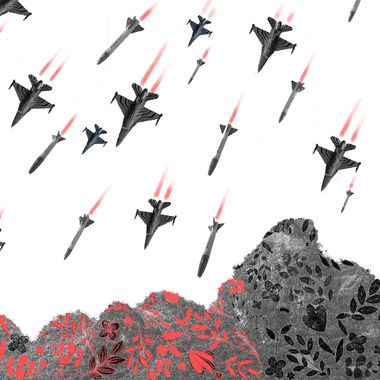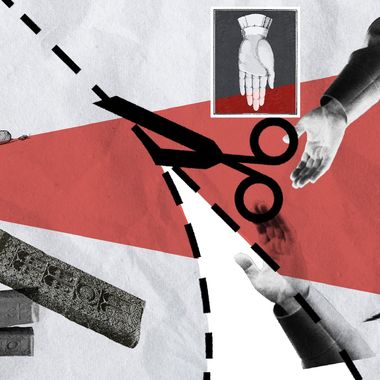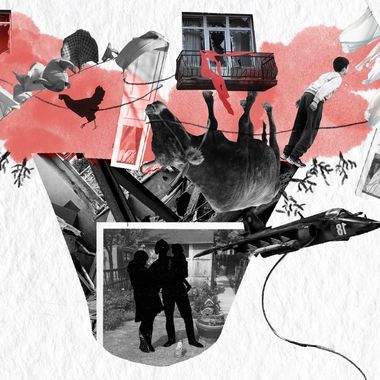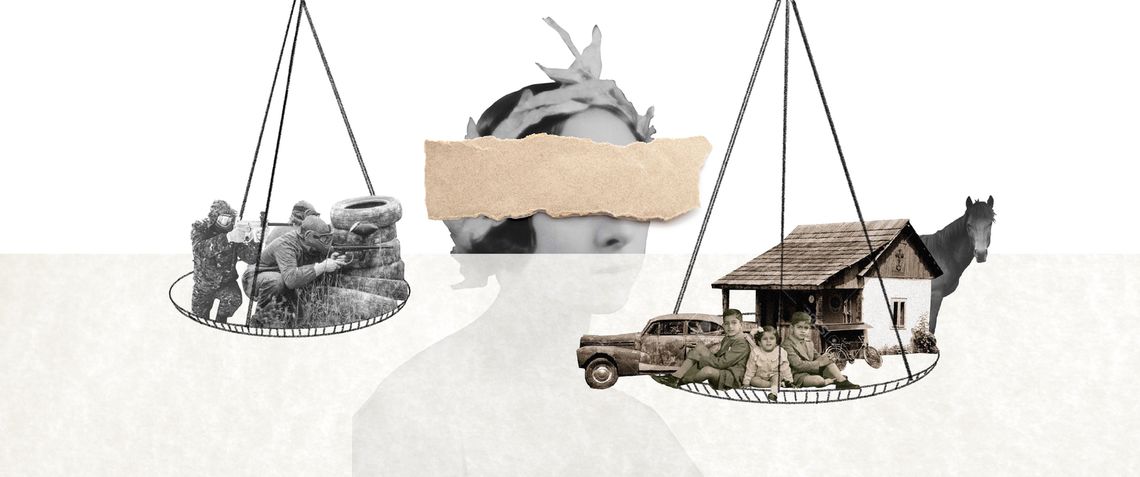
Illustration by Armine Shahbazyan.
The military phase of the 2020 Artsakh War seems to have ended but the legal fight for restoring and upholding human rights is just beginning.
On February 1, the Armenian Government submitted an Inter-State Application against Azerbaijan to the European Court of Human Rights (ECtHR) claiming violations of the rights of the people of Artsakh and Armenia guaranteed by the European Convention on Human Rights (ECHR). The right to life, prohibition of torture and inhuman treatment, the right to liberty, the right to property, the right to personal and family life and the right to education are among the articles of the Convention that the Armenian Government claims Azerbaijan violated both during and in the aftermath of the 2020 Artsakh War. The Government also raised issues pertaining to the protection of the rights of prisoners of war (POWs), civilian captives, displaced people, and local and international reporters.
Inter-State Application and Interim Measures
Most of the applications to the ECtHR are submitted by individuals, groups of individuals, NGOs or companies. Although applications lodged by states against each other do not happen very often, Article 33 of the Convention allows for it, stating that “any High Contracting Party may refer to the Court any alleged breach of the provisions of the Convention and the Protocols thereto by another High Contracting Party.” Since the ratification of the Convention in 1953, only 27 inter-state cases have been brought before the Court. On February 1, Armenia submitted its first inter-state application to the ECtHR.
The Office of Armenia’s Representative at the ECtHR submitted a number of requests for interim measures under Rule 39 of the Rules of the Court, the goal of which was to prevent violations of rights guaranteed by the Convention while the war was still going on. According to the Court’s well-established practice, requests for interim measures are fulfilled only when there is an “imminent risk of irreparable harm.” Despite the Court’s calls to all states directly or indirectly involved in the conflict to refrain from actions that contribute to breaches of the Convention rights of civilians or to inform the Court of the measures taken to comply with their obligations, Azerbaijan’s government failed to fulfill the Court’s decisions. In fact, Azerbaijan continued its tactics of indiscriminate attacks and intentional targeting of civilian settlements.
Yeghishe Kirakosyan, Armenia’s Representative at the ECtHR, believes that interim measures proved to be quite ineffective in Armenia’s case and did not serve as preventive mechanisms. However, it was an expected outcome for the Armenian side, considering the countries that were involved in the war. “We are speaking about countries whose track record is very telling when it comes to human rights violations,” added Kirakosyan. Turkey, which actively supported Azerbaijan militarily and diplomatically throughout the war, is among the problematic countries of the Council of Europe. In 2019, Turkey had a record number of 9,236 pending cases before the ECtHR (second only to Russia’s 15,037). Also, in 2019, the ECtHR delivered 113 judgments concerning Turkey, 97 of which found at least one violation of the European Convention.
Kirakosyan, however, believes that the fact that interim measures proved to be ineffective does not mean that the Armenian side should not have initiated those proceedings. Quite the opposite, interim measures were part of the strategic and long-term process and helped set the ground for filing an inter-state application. Kirakosyan explained that, when a state submits requests for interim measures, it indirectly communicates its intention to file an inter-state application.
The Armenian side continued to extensively use this tool in the aftermath of the war as well, but again without much success. On a number of accounts, the Court applied interim measures based on the applications of individual lawyers and the Government for the protection of the rights of Armenian servicemen and civilians in Azerbaijani captivity. The European Court required the Azerbaijani government to submit information about their whereabouts, the conditions in which they are being kept and the medical care provided to them. In the majority of cases, Azerbaijan violated the deadlines set by the Court and failed to provide comprehensive information about Armenian POWs, in violation of Article 34 of the Convention. Kirakosyan noted that it is rare for member states to show such a blatant disregard and disrespect toward Court orders. “This is a fundamental problem and, at some point, Azerbaijan's membership may be put up for discussion,” he added.
The Right to Life
Armenia’s application provides a detailed account of the violations that were registered during the 44-day war. A large amount of supporting evidence has been submitted regarding the arguments and claims raised in the application. Violations of the fundamental right to life, guaranteed under Article 2 of the Convention, is one of the key sections.
According to official sources, approximately 4,000 servicemen were killed during the war. An interim report by the Artsakh Ombudsman’s Office states that 72 civilians were killed and another 163 were injured throughout the hostilities. Speaking about the applicability of Article 2, Kirakosyan noted that it first of all refers to civilian casualties and does not apply to combatants. International humanitarian law is very clear on the issue and states that those participating in military activities are considered legitimate targets. Kirakosyan said that the application presents instances where combatants were treated in an inhumane and degrading manner, or were killed while in Azerbaijani captivity. Thus, Article 2 also applies to POWs and other detainees who were tortured and eventually killed by Azerbaijani forces.
The example of Arsen Gharakhanyan, a 43-year-old resident of the Hadrut region whose body was recovered on January 18, is a case in point. According to his wife, Gharakhanyan was in Azerbaijani captivity and was seen in a video on January 7. Kirakosyan confirmed the information in an interview with Azatutyun and said that the Armenian side has submitted video evidence to the ECtHR, which proves that Gharakhanyan was, in fact, in Azerbaijani captivity. Kirakosyan also said that, according to their information, Gharakhanyan was killed recently, in violation of the European Convention.
According to the latest updates, February 1 was the deadline set by the ECtHR for Azerbaijan to provide information about a list of Armenian POWs for whom it approved the use of interim measures. At the time of the interview with Kirakosyan (February 3), Azerbaijan had not yet provided the requested information. Kirakosyan explained that, if Azerbaijan continues to ignore the Court’s decisions, there is a chance that the issue will be discussed before the Committee of Ministers of the Council of Europe. This will add a political context to the issue, since foreign ministers or permanent diplomatic representatives of member states will take part in the discussions. “We believe that those discussions will put extra pressure on Azerbaijan,” added Kirakosyan. Azerbaijani delegates will have a difficult time giving evasive answers to the concerns and questions raised by the delegates of other member states.
The return of POWs and civilian captives is mandatory in accordance with the norms of international humanitarian law and the Geneva Conventions, which require states to immediately return POWs and all other detainees after the cessation of hostilities. Kirakosyan said that the European Court is only a supplementary measure in this regard. The steps of the Armenian Government are aimed at ensuring that Azerbaijan confirms the captivity of Armenian detainees, which is expected to serve as an additional restraining factor for Azerbaijani authorities. To date, 68 Armenian POWs and civilian captives have been returned to Armenia. According to Siranush Sahakyan, a lawyer representing Armenian POWs before the ECtHR, 223 Armenian military prisoners and civilian hostages still remain under Azerbaijani captivity.
The Right to Property
During the past 28 years, the Hayastan All Armenian Fund alone made $110 million worth of investments in territories of Artsakh that are now under Azerbaijani control.
Another section of the application addresses the issue of properties that were damaged or destroyed as a result of shelling, as well as properties that were left outside of Armenia’s control. Private properties, businesses, years of investments, infrastructure, hydro power plants, schools and agricultural lands were levelled or handed over to Azerbaijani authorities. Kirakosyan noted that, due to the efforts of the former Ombudsman of Artsakh Artak Beglaryan, there is substantive documentation of the scope of the damage. Fact-finding missions that started working on the ground in the first days of the war collected extensive evidence and documented the damage and destruction that was caused. Kirakosyan noted that, as part of the inter-state application, additional evidence will be submitted from the cadastre databases, which would provide detailed descriptions of the complete list of properties that were in the territories of 118 communities now under Azerbaijani control. Kirakosyan said that, under the Convention, residents of those communities cannot possibly return to their homes and are deprived of their right to exercise control over their properties.
Azerbaijan’s Inter-State Application
Azerbaijan lodged an inter-state application against Armenia, alleging Convention violations as well. Azerbaijan accuses Armenia of shelling civilian settlements with ballistic missiles and cluster munitions during the 2020 war, as a result of which 93 civilians were killed and another 423 were wounded. Violations of property rights are also raised, citing 264 buildings and 9,294 private houses destroyed due to the shelling. A significant part of Azerbaijan’s application refers back to the consequences of the First Karabakh War in the early 1990s and the inaction of the Armenian authorities with regard to the fate of over 3,000 Azerbaijanis who went missing.
Kirakosyan believes that the examination of questions dating back to the First Karabakh War is beyond the jurisdiction of the Court. At the time, neither Armenia nor Azerbaijan were member states of the Council of Europe and the retroactive application of the Convention can be problematic. Both Armenia and Azerbaijan joined the Council of Europe on January 25, 2001.
The Court did examine Sargsyan vs. Azerbaijan and Chiragov and others vs. Armenia, both of which dealt with issues dating back to the early 1990s. Kirakosyan noted that questions may arise as to why Azerbaijan did not submit all of its claims against Armenia after it became a member state of the Council of Europe. Kirakosyan also said that the ECtHR is not inclined to address issues that happened a long time ago. “For the Court, it is like opening a Pandora’s box. It will set a precedent for other member states to submit applications that refer back to issues that took place a long time ago,” he added.
The imperative to protect human rights must be a daily endeavor for all - for those in positions of power and for ordinary citizens. Protecting human rights must include daily acts of courage and resilience, not only during times of war, but also in peacetime. EVN Report's December 2020, issue “Dignity” is dedicated to himan rights.
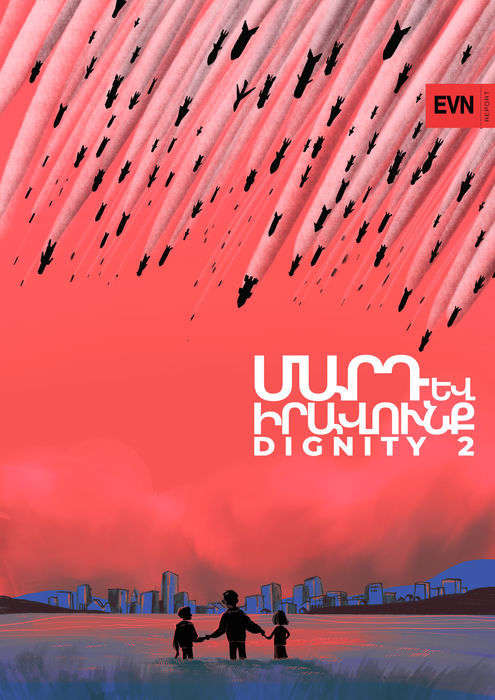
War Crimes and Possible Ways to Achieve Justice
By Ara Khzmalyan
Different international courts have jurisdiction over different areas of international law. Ara Khzmalyan explains the avenues available for demanding accountability for the war crimes committed against Artsakh.
Azerbaijan’s War Crimes
By Hovhannes Nazaretyan
Numerous war crimes were committed during and after the 2020 Artsakh War. This article provides an overview and lists many of the most horrendous and brutal war crimes committed by Azerbaijani military against Armenian servicemen and civilians.
Azerbaijan’s Anti-Armenian Policies Before the Artsakh War
By Lusine Sargsyan
Although the severity of war crimes committed by Azerbaijan and its disregard for international humanitarian law was unprecedented during the 2020 Artsakh War, it is a continuation of official Baku’s anti-Armenian policy stretching back over a century.
Hanging in the Air: When Even Your Displacement Is Unrecognized
By Gohar Abrahamyan
The thousands displaced by the 2020 Artsakh War are asking “What do you expect me to do?” But, no one has an answer for them.
The Children of War: On the Brink of Life and Death
By Astghik Karapetyan
Children also became a target of Azerbaijan’s large-scale military aggression during the 2020 Artsakh War. Their basic rights to life, health, family and community were consistently violated.
Comments
Barbara Kraft
2/14/2021, 7:49:40 PMWhat steps must the government and the people take to achieve economic security, guarantee democratic freedoms, and ensure the stability that will allow people to work, create, and prosper?stability?



